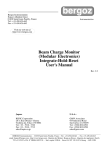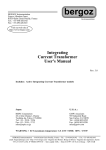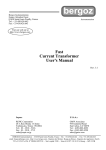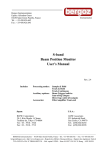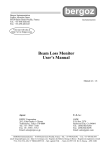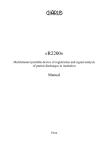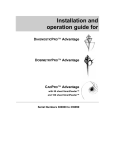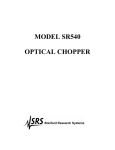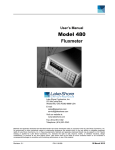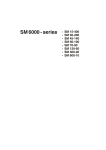Download ICT
Transcript
BERGOZ Instrumentation Espace Allondon Ouest 01630 Saint Genis Pouilly, France Tel.: +33-450.426.642 Fax: +33-450.426.643 bergoz Instrumentation Visit our web site at http://www.bergoz.com Beam Charge Monitor Integrate-Hold-Reset User's Manual Rev. 1.8.1 Japan: U.S.A.: REPIC Corporation 28-3, Kita Otsuka 1-Chome Toshima-ku, Tokyo 170-0004 Tel.: 03 - 3918 - 5326 Fax: 03 - 3918 - 5712 [email protected] GMW Associates 955 Industrial Road San Carlos, CA 94070 Tel.: (650) 802-8292 Fax: (650) 802-8298 [email protected] BERGOZ Instrumentation - 01630 Saint Genis Pouilly, France - Tel.: +33-450.426.642 - Fax: +33-450.426.643 email: [email protected] - http://www.bergoz.com - Registre des Métiers: Bourg-en-Bresse - Registre des ingénieurs: Zurich BERGOZ Instrumentation 01630 Saint Genis Pouilly, France Tel. +33-450.426.642 Fax +33-450.426.643 Beam Charge Monitor Integrate-Hold-Reset Page 1 User's manual SUMMARY Page INITIAL INSPECTION ................................................................. WARRANTY ............................................................................. ASSISTANCE ........................................................................... SERVICE & RETURN PROCEDURES ............................................. YOU JUST RECEIVED YOUR BCM ................................................ QUICK CHECK ......................................................................... Front panel ..................................................................... Jumpers configuration for quick check ..................................... Set-up ........................................................................... Waveforms ..................................................................... Your BCM does not behave as described ................................... Testing all other BCM functions ............................................. GENERAL DESCRIPTION.............................................................. Purpose.......... ................................................................. System components........ ..................................................... ARCHITECTURE.......... ............................................................... OPERATING PRINCIPLE............................................................... Integrating Current Transformer......... ...................................... Fast Current Transformer....................................................... Cable connection................................................................. Signal processing........ ........................................................ Timing of the BSP-IHR .... .................................................. Beam Charge Monitor output................................................... Virtual zero Ω input............................................................. On-line calibration......... ...................................................... SENSITIVITY OF THE BCM-IHR....... .............................................. Full scale with 50Ω input mode................................................ Full scale with virtual 0Ω input mode......................................... Most sensitive configuration.................................................... Least sensitive configuration.................................................... REMOTE RANGE and CALIBRATION SWITCHING.............................. MAKING PRECISE MEASUREMENTS WITH THE BCM........................ SETTINGS........ ......................................................................... Charge Amplifier................................................................. Bunch Signal Processor......................................................... Power Supply...... .............................................................. SPECIFICATIONS........................................................................ Integrating Current Transformer......... ...................................... Charge Amplifier and Calibration Generator....... .......................... Bunch Signal Processor - IHR................................................. Power Supply......... ........................................................... CONNECTOR PINS ALLOCATION................................................... BNC rear connectors............................................................ DB9 male Remote Control connector.......................................... Charge Amplifier and Calibration (CAC) DIN 41612 rear connector..... Bunch Signal Processor (BSP) DIN 41612 rear connector................. BACKPLANE WIRING DIAGRAM........ ........................................... 3 3 3 3 4 4 5 5 7 7 11 11 12 12 12 13 14 14 15 15 16 17 18 18 19 20 20 20 20 20 21 22 23 24 25 26 27 27 27 28 28 29 29 29 30 30 31 Cont'd next page BERGOZ Instrumentation 01630 Saint Genis Pouilly, France Tel. +33-450.426.642 Fax +33-450.426.643 SUMMARY Beam Charge Monitor Integrate-Hold-Reset Page 2 User's manual (Cont'd) INSTALLATION ON THE VACUUM CHAMBER.................................. Break in the vacuum chamber electrical continuity........................... Vacuum chamber impedance................................................... Wall current by-pass and RF shield........................................... Thermal protection of the ICT.................................................. Keeping high harmonics of the beam out of the cavity...................... LONG CABLE LOSS ON-SITE CALIBRATION .................................... Proposed method................................................................ Establish the reference pulse.................................................... Cable loss correction............................................................ Correcting the internal calibration generator for long cable................. Annex I. Annex II. Annex III. Annex IV. Annex V. Annex VI. 32 32 33 33 33 34 36 36 37 38 39 Test of Cable Length Incidence on BCM Linearity Delta Elektronika U-Series Linear Power Supply data sheet Measuring Bunch Intensity... in LEP, K.B. Unser Beam Current Measurement... at the HERA Proton Ring, W. Schütte, K.B.Unser Fast Bunch-to-Bunch Current Sampling in the Cornell e–/e+ Collider, C.R. Dunnam Bunched Beam Measurement of Small Currents at ASTRID, F. Abildskov et al. BERGOZ Instrumentation 01630 Saint Genis Pouilly, France Tel. +33-450.426.642 Fax +33-450.426.643 Beam Charge Monitor Integrate-Hold-Reset Page 3 User's manual INITIAL INSPECTION It is recommended that the shipment be inspected immediately upon delivery. If it is damaged in any way, contact Bergoz Instrumentation or your local distributor. The content of the shipment should be compared to the items listed on the invoice. Any discrepancy should be notified to Bergoz Instrumentation or its local distributor immediately. Unless promptly notified, Bergoz Instrumentation will not be responsible for such discrepancies. WARRANTY Bergoz Instrumentation warrants its beam current monitors to operate within specifications under normal use for a period of 12 months from the date of shipment. Spares, repairs and replacement parts are warranted for 90 days. Products not manufactured by Bergoz Instrumentation are covered solely by the warranty of the original manufacturer. In exercising this warranty, Bergoz Instrumentation will repair, or at its option, replace any product returned to Bergoz Instrumentation or its local distributor within the warranty period, provided that the warrantor's examination discloses that the product is defective due to workmanship or materials and that the defect has not been caused by misuse, neglect, accident or abnormal conditions or operations. Damages caused by ionizing radiations are specifically excluded from the warranty. Bergoz Instrumentation and its local distributors shall not be responsible for any consequential, incidental or special damages. ASSISTANCE Assistance in installation, use or calibration of Bergoz Instrumentation beam current monitors is available from Bergoz Instrumentation, 01630 Saint Genis Pouilly, France. It is recommended to send a detailed description of the problem by fax. SERVICE PROCEDURE Products requiring maintenance should be returned to Bergoz Instrumentation or its local distributor. Bergoz Instrumentation will repair or replace any product under warranty at no charge. The purchaser is only responsible for transportation charges. For products in need of repair after the warranty period, the customer must provide a purchase order before repairs can be initiated. Bergoz Instrumentation can issue fixed price quotations for most repairs. However, depending on the damage, it may be necessary to return the equipment to Bergoz Instrumentation to assess the cost of repair. RETURN PROCEDURE All products returned for repair should include a detailed description of the defect or failure, name and fax number of the user. Contact Bergoz Instrumentation or your local distributor to determine where to return the product. Returns must be notified by fax prior to shipment. Return should be made prepaid. Bergoz Instrumentation will not accept freight-collect shipment. Shipment should be made via Federal Express or United Parcel Service. Within Europe, the transportation service offered by the Post Offices "EMS" (Chronopost, Datapost, etc.) can be used. The delivery charges or customs clearance charges arising from the use of other carriers will be charged to the customer. BERGOZ Instrumentation 01630 Saint Genis Pouilly, France Tel. +33-450.426.642 Fax +33-450.426.643 Beam Charge Monitor Integrate-Hold-Reset Page 4 User's manual YOU JUST RECEIVED YOUR BCM.... Check that the voltage corresponds to your mains voltage. The power supply voltage is indicated on the plastic label located on the power supply module front panel. If it does not correspond, go to Annex III: Delta Elektronika U-Series linear power supply data sheet to adjust the power supply to your mains, and change the fuse and front-panel plastic label accordingly. QUICK CHECK You can check immediately that your BCM is working. This is what you need: • • • • • Beam Charge Monitor Integrate-Hold-Reset DB9 Remote control key Integrating Current Transformer (or Fast Current Transformer) 4-channel oscilloscope (or 2-channel with memory) with 100 MHz bandwidth or better. Pulse generator capable of making the trigger pulse (≥10 ns, ≥2.4V, 1 kHz) You will also need short (4-8 ns) cables and SMA-BNC adapters. Verify that this manual corresponds to your BCM version The BCM version is marked on the front panel handle of the Bunch Signal Processor module: • "BSP-CA" for a BCM-CA • "BSP-IHR" for a BCM-IHR. Your configuration may include a Wideband Amplifier. This manual covers the BCM-IHR: Beam Charge Monitor, Integrate Hold Reset version (order code: BCM-IHR). It does not cover the BCM-CA. Another manual titled "Beam Charge Monitor Continuous Averaging" covers the BCM-CA with and without the BCM-WBA Wideband Amplifier. DB9 Remote control key A "DB9 Remote control key" is supplied with the Beam Charge Monitor. It is a small auxiliary printed board attached to a DB9 connector. An 8-bit switch is mounted on the printed board. It must be plugged to the DB9 Remote control connector at the rear of the BCM to allow range switching and calibration range switching during tests. Switches A0...A6 are active. They correspond to Bits 0...6 of the remote control (See “Remote Range and Calibration Switching”, this manual). Position 1 corresponds to bit HIGH. Position 0 corresponds to bit LOW. Switch A7 is not connected. Bit 7 controls “Calibration Enable”. This 0 function can be enabled during tests by the BCM front panel switch. DB9 Remote control key REMOTE CONTROL 1 BERGOZ Instrumentation 01630 Saint Genis Pouilly, France Tel. +33-450.426.642 Fax +33-450.426.643 Beam Charge Monitor Integrate-Hold-Reset Page 5 User's manual Front panel bergoz bergoz Charge Amplifier Bunch Signal Processor Off On Calibration Delay Signal View Calibration View Output View Trigger δ Tw Input Timing View Output View Signal Input delay Trigger View C.A.C. B.S.P. I-H-R Font panel The modules have labels on the handles identifying the version "IHR" or "CA". WARNING: Jumpers configuration & Potentiometers settings Your BCM is in the "Ex-factory" configuration. Jumper and timing adjustments (potentiometers) have been configured according to your order. Do not change those settings until you are familiar with the Beam Charge Monitor. BERGOZ Instrumentation 01630 Saint Genis Pouilly, France Tel. +33-450.426.642 Fax +33-450.426.643 Beam Charge Monitor Integrate-Hold-Reset Page 6 User's manual Setup ICT (or FCT) Beam Charge Monitor Pulse Generator 10ns - 2.4V - 1 kHz Charge Amplifier Power Supply Bunch Signal Processor Ch1 Trig. Connect the beam current transformer to the Signal Input of the Charge Amplifier. Insert the "Remote Control" key in the DB9 connector at the rear of the Beam Charge Monitor. Note: All Remote Control switches should be OFF. Connect the BCM to the mains. Apply to the Trigger Input a pulse: Polarity: Positive Width ≥ 10 ns Amplitude: ≥ 2.4V v Repetition rate: 1 kHz Impedance: 50Ω Apply same pulse to the oscilloscope trigger. Turn the front-panel "Calibration" switch ON. Now look at the signals with the oscilloscope. All View points are on the front panel: Waveforms Connect the BSP Trigger View output to the oscilloscope. It should look like this: Trigger View BERGOZ Instrumentation 01630 Saint Genis Pouilly, France Tel. +33-450.426.642 Fax +33-450.426.643 Beam Charge Monitor Integrate-Hold-Reset Page 7 User's manual Waveforms (cont'd) Connect the Charge Amplifier Calibration View output to the oscilloscope. It should look like this: Calibration View Connect the Charge Amplifier Output View to the oscilloscope. It should look like this: Charge Amplifier Output View BERGOZ Instrumentation 01630 Saint Genis Pouilly, France Tel. +33-450.426.642 Fax +33-450.426.643 Beam Charge Monitor Integrate-Hold-Reset Page 8 User's manual Waveforms (cont'd) Connect the Bunch Signal Processor Signal View to the oscilloscope. It should look like this: Bunch Signal Processor Signal View Connect the Bunch Signal Processor Timing View to Channel 1 of the oscilloscope, and Signal View to Channel 2. It should look like that: Bunch Signal Processor Timing View and Signal View BERGOZ Instrumentation 01630 Saint Genis Pouilly, France Tel. +33-450.426.642 Fax +33-450.426.643 Beam Charge Monitor Integrate-Hold-Reset Page 9 User's manual Waveforms (cont'd) To view the Bunch Signal Processor Output in relation to the other signals, connect the Bunch Signal Processor Output View to channel 3 of your oscilloscope. If you use a 2-channel oscilloscope, memorize the Timing View waveform and connect Output view to Channel 1. It should looks like this: Top to bottom: Memorized Timing View, BSP Output View and BSP Input View Turn the Charge Amplifier front-panel "Calibration Delay" 20-turn potentiometer: It changes the delay between the trigger and the calibrated pulse. The calibrated pulse can be moved from the second window (the "adding" window) into the first window (the "subtracting" window). When the calibrated pulse fits entirely into the first (subtracting) window, it should look like this: Top to bottom: Memorized Timing View, BSP Output View and BSP Input View BERGOZ Instrumentation 01630 Saint Genis Pouilly, France Tel. +33-450.426.642 Fax +33-450.426.643 Beam Charge Monitor Integrate-Hold-Reset Page 10 User's manual Waveforms (cont'd) Adjust your oscilloscope time base to a slower sweep: 50 µs / div. It should look like this: The BSP-IHR cycle Top to bottom: Timing View, BSP Output View and BSP Input View The complete BSP-IHR cycle is visible on the oscilloscope including the BSP output reset to zero. Explanation of the Timing View: The Timing View is a signal to help the user: a) adjust the beam pulse in the integration window b) adjust the timing of his readout ADC or sampling voltmeter with the BSP output signal. The voltage levels of the Timing View are arbitrary. • Signal lowest level, at the beginning of the trace: The Beam Charge Monitor is ready to receive a Trigger. • First step up: The BSP has received a Trigger, the Trigger delay is elapsing (4µs in ex-factory conditions) • Second step up: The trigger delay has elapsed, the first integration window starts. In ex-factory conditions it lasts 4 µs. During this window, the signal is summed in the output with a negative sign. It is the "Subtracting" window. • Next step is down: The first or "Subtracting" window has closed. The second window starts. In ex-factory conditions, this window has equal duration than the first window. During this window, the input signal is summed with a positive sign. It is the "Adding" window. • Next step down: The second window has closed. The Hold time starts. During the hold time, the BSP output value is held. In ex-factory conditions the Hold time terminates 400 µs after the trigger. • Next step down: The Hold time is finished. The BSP output is reset to zero. The Beam Charge Monitor is ready to receive another Trigger. BERGOZ Instrumentation 01630 Saint Genis Pouilly, France Tel. +33-450.426.642 Fax +33-450.426.643 Beam Charge Monitor Integrate-Hold-Reset Page 11 User's manual Your BCM-IHR does not behave as described If your BCM-IHR is in ex-factory conditions, it should behave as described. If it does not, check the switch settings on the "Remote Control" key: All switches should be in the OFF position. If your BCM-IHR is not anymore in ex-factory conditions, the front panel potentiometers settings may have been changed. To reestablish the ex-factory settings: • Turn potentiometer "delay" located in the BSP front-panel "Trigger View" frame until the Trigger delay equals 4 µs. • Turn potentiometer "Tw" located in the BSP front-panel "Timing View" frame until the integration window width equals 4 µs. • Turn potentiometer "Calibration Delay" on the Charge Amplifier front panel until the calibrated pulse fits into an integrating window. If those adjustments cannot be effected, the instrument's time constants have probably been changed after delivery of the instrument. Either restore original values according to the schematics or contact manufacturer for recalibration. Testing all other BCM functions You can test all gain ranges, inverse the signal polarity, change the value of the calibration pulse and its polarity: Move the switches of the DB9 Remote control key. Place the switches A0 to A6 according to "Remote Range and Calibration Switching". Switch position 1 corresponds to bit HIGH. Position 0 to bit LOW. Note that Switch A7 is not connected. The "Calibration Enable" command can be activated with the BCM front panel switch. BERGOZ Instrumentation 01630 Saint Genis Pouilly, France Tel. +33-450.426.642 Fax +33-450.426.643 Beam Charge Monitor Integrate-Hold-Reset Page 12 User's manual GENERAL DESCRIPTION The BCM is made in two versions: • Integrate-Hold-Reset "IHR" version for pulse repetition rates from 1 kHz down to single pulses • Continuous Averaging "CA" version for pulse repetition rates from 10 MHz down to 5 kHz. This manual describes the Integrate-Hold-Reset "IHR" version. Purpose The Integrate-Hold-Reset version measures the charge in a single selected pulse or macro-pulse. The Continuous Averaging version measures the average charge over time, of repetitive selected pulses or macro-pulses. The Continuous Averaging version, therefore, measures currents. System components In a beam line or particle accelerator application, the BCM detects the beam signal with a nondestructive sensor: • Integrating Current Transformer (ICT), or • Fast Current Transformer (FCT) Note: The Beam Charge Monitor virtual 0Ω input cannot be used when an FCT is used as sensor. See: "Virtual 0Ω Termination" in "Operating Principle" chapter in this manual) The signal may be amplified by an optional wideband amplifier (BCM-WBA) before being delivered to an electronics mini-crate by a (user's supplied) coaxial cable. In this mini-crate, there are 3 modules: • Charge Amplifier and Calibration Generator (CAC) • Bunch Signal Processor (BSP), and • Power Supply. The BCM output is delivered by the Bunch Signal Processor. It is a voltage up to ±7V proportional to the beam charge. In the Integrate-Hold-Reset "IHR" version, the voltage level it held up to 400µs, then reset. In the Continuous Averaging "CA" version, the voltage level averages the successive input pulses with a long time constant. ICT (or FCT) Beam Charge Monitor Beam Charge Amplifier Power Supply Sampling voltmeter 9999999 Bunch Signal Processor Trigger pulse On the BCM rear: BCM output To the BCM rear: Range selection, calibration selection and command BCM system represented without the optional wideband amplifier. BERGOZ Instrumentation 01630 Saint Genis Pouilly, France Tel. +33-450.426.642 Fax +33-450.426.643 Beam Charge Monitor Integrate-Hold-Reset Page 13 User's manual ARCHITECTURE + 0dB Non-invert + 6dB + 6dB Invert +20dB +12dB +20dB CHARGE AMPLIFIER Signal Input 0Ω GA Virtual 0Ω load Remote control Ranges DB9 Line driver Calibration enable 50Ω ± 1dB Output View Fine Gain Calibration ranges Trigger input CALIBRATION GENERATOR Calibration Delay 10 pC 1 pC Buffer Trigger BNC Attenuators Cal.+ Calibration View Calibration On / Off 100 pC Pulse Gen. Cal.- Time base 1nC Voltage Ref. Ext. Calibration Control On Off BUNCH SIGNAL PROCESSOR Signal View 20:1 Zero Offset Output View + – Adding window integrator GA-IHR Reset Subtracting window integrator GA-IHR Window Balancing Reset Timing View Trigger View Trigger delay Sequence Generator Trigger delay Window width Window width Tw Hold or Cycle time Output Output BNC POWER SUPPLY ±15V Voltage selector Mains BERGOZ Instrumentation 01630 Saint Genis Pouilly, France Tel. +33-450.426.642 Fax +33-450.426.643 Beam Charge Monitor Integrate-Hold-Reset Page 14 User's manual OPERATING PRINCIPLE Integrating Current Transformer The Integrating Current Transformer (ICT) is a passive transformer designed to measure the charge in a very fast pulse with high accuracy. It is capable of integrating a pulse with rise time in the order of picoseconds with no significant loss. N [turns] U out Output 50 Ω ICT 50Ω User connection The ICT is a capacitively shorted transformer coupled to a fast readout transformer in a common magnetic circuit1 . The ICT delivers a pulse with ca. 20 ns rise time irrespective of the beam pulse rise time. The ICT output pulse charge is in exact proportion to the beam pulse charge. Integrating Current Transformer Beam pulse Output pulse 10ns/div The sensitivity of the Integrating Current Transformer is also called the transfer impedance. It depends on the ICT model. It is expressed in terms of the integral of the output pulse voltage as a function of the input pulse charge, therefore in V.s/C, or Ω. ICT Model Sensitivity Beam charge to Beam charge to in a 50Ω input charge ratio input charge ratio termination in BCM 50Ω input in BCM 0Ω input ICT-XXX-XXX-50:1 0.50 V.s/C 100:1 ≈ 50:1 ICT-XXX-XXX-20:1 1.25 V.s/C 40:1 ≈20:1 ICT-XXX-XXX-10:1 2.50 V.s/C 20:1 ≈ 10:1 ICT-XXX-XXX-05:1 5.00 V.s/C 10:1 ≈ 5:1 Measuring Bunch Intensity, Beam Loss and Bunch Lifetime in LEP, K.B.Unser, Proceedings of the 2nd European Particle Accelerator Conference, 1990, Vol.1, p.786 1 BERGOZ Instrumentation 01630 Saint Genis Pouilly, France Tel. +33-450.426.642 Fax +33-450.426.643 Beam Charge Monitor Integrate-Hold-Reset Page 15 User's manual Fast Current Transformer The Fast Current Transformer (FCT) is a passive AC transformer with <1ns rise time and droop lower than 5 %/µs. Fast Current Transformers are made with 20:1, 10:1 and 5:1 turns ratios into a 50Ω load. The FCT is specifically designed to observe bunched beams in particle accelerators. U out Output 50Ω FCT 50Ω User connection It can be used as beam sensor in a Beam Charge Monitor when the sensor must have the dual purpose of (a) looking at the beam longitudinal profile with an oscilloscope, and (b) measuring the beam charge with a Beam Charge Monitor. But the Integrating Current Transformer is preferable. The sensitivity of the Fast Current Transformer is also called the transfer impedance. It depends on the FCT model. It is expressed in terms of output pulse voltage as a function of the input pulse current, therefore in V/A, or Ω. FCT Model Sensitivity Beam charge to Beam charge to in a 50Ω input charge ratio input charge ratio termination in BCM 50Ω input in BCM 0Ω input FCT-XXX-50:1 0.50 V/A 100:1 Cannot be used FCT-XXX-20:1 1.25 V/A 40:1 Cannot be used FCT-XXX-10:1 2.50 V/A 20:1 Cannot be used FCT-XXX-05:1 5.00 V/A 10:1 Cannot be used Cable connection When a Fast Current Transformer is used as beam sensor, the choice of the cable may be critical. The cable must be capable of carrying the frequency spectrum of the signal with acceptable integration and differentiation. With fast beam pulses, the FCT limits the risetime somewhere below 1ns. When using an Integrating Current Transformer as beam sensor, the choice of the cable is much less critical, because the ICT output pulse has a risetime of 20 ns (unless it is a special model with short output pulse). We made tests with long, low-quality cable. Those tests are reported in Annex I, Test of cable length incidence on BCM linearity. BERGOZ Instrumentation 01630 Saint Genis Pouilly, France Tel. +33-450.426.642 Fax +33-450.426.643 Beam Charge Monitor Integrate-Hold-Reset Page 16 User's manual Signal processing The signal is amplified by the Charge Amplifier. The amplified signal is entered, via the backplane, into the Bunch Signal Processor (BSP). The BSP integrates this signal whenever the BCM is triggered by an external trigger. This gives the possibility to measure only selected pulses, not necessarily at a fixed repetition rate. The trigger can be applied to the Charge Amplifier front panel, or to the BNC connector located at the back of the BCM mini-crate. The signal processing is initiated by the external positive-going trigger pulse. A sequence timer creates three successive time windows: a trigger delay, a subtracting window and an adding window. The pulse to be integrated must fall either in the adding window, or the subtracting window. Pulses falling in the first window or trigger delay are not integrated. At the start of the first integration window, the baseline is clamped to set the zero reference. The two integration windows are used to integrate the input signal in two independent integrators. trigger input sequence timer fast buffer gated integrator gated integrator offset error correction baseline clamping fast buffer diff. ampl. Lowpass filter Out One integrator integrates the pulse signal. The other integrates the input noise and baseline offset. The pulse charge is obtained by summing the two integrators: the first with negative sign, the second with positive sign. This particular combination of sampling window integrators gives a high degree of noise suppression. All signals which do not correlate in frequency and in time with the window timing are rejected. This is true for the amplifier noise and also for the general background. The balance of integrators gains is user-adjustable with the Window Balancing potentiometer P1. BERGOZ Instrumentation 01630 Saint Genis Pouilly, France Tel. +33-450.426.642 Fax +33-450.426.643 Beam Charge Monitor Integrate-Hold-Reset Page 17 User's manual Timing of the BSP-IHR Trigger (10ns min) Signal input Timing view output signal Output signal Tc Cycle time Trigger delay Tc Cycle time Trigger delay Tw Tw Baseline Subtracting clampling Adding window window Tw Tw Baseline Subtracting clampling Adding window window The Trigger delay is adjustable with front-panel potentiometer P3 labelled "delay" in "Trigger View" frame of the BSP. The trigger delay is determined by the P3 x C34 time constant. The two integration windows are of equal width "Tw". T w is adjustable with front-panel potentiometer P2 labelled "Tw" in the "Timing View" frame of the BSP module. Tw is determined by the P2 x C36 time constant. The Hold time or Cycle duration Tc is determined by the time constant P4 x C37. P4 is useradjustable. It is located on the BSP board. C37 can be changed to another value. The cycle duration Tc must not be made shorter than the sum of the trigger delay and the two integration windows. BERGOZ Instrumentation 01630 Saint Genis Pouilly, France Tel. +33-450.426.642 Fax +33-450.426.643 Beam Charge Monitor Integrate-Hold-Reset Page 18 User's manual Beam Charge Monitor Output The output is a DC level up to ±7V, proportional to the pulse charge. The output voltage is the difference between the value of the Subtracting Integrator and the Adding Integrator. The output may have an offset. This output zero offset is user adjustable with the Zero Offset potentiometer P6 located on the BSP board. To eliminate this offset and make precision measurement, see chapter "Making precise measurements with the BCM", in this manual. The output is available on the BNC at the rear of the Beam Charge Monitor. (See "BCM Backplane Wiring Diagram" chapter in this manual). It is also available for oscilloscope viewing from the BSP front-panel connector "Output View". In the "IHR" Integrate-Hold-Reset version, the output is the value of the last selected pulse only. The signal settles in < 20 µs after the end of the second window; it is held at that level until the end of the cycle, then it is reset to zero. The Cycle time Tc or "Hold time" can be adjusted with the P4 potentiometer located on the BSP board. Virtual zero Ω input Not applicable when optional Wideband Amplifier is used. In the Charge Amplifier, a special feature2 makes the input impedance a virtual zero Ω, instead of 50Ω. This can only be used with slow-rising signals, because the active circuits are limited in slew rate. In practice, pulses with rise times down to 20 ns are well integrated. Below 10 ns risetime, there is significant non linearity. Signals generated by an ICT with standard 70 ns output pulses are integrated without charge loss. When using an FCT as beam sensor, the signal can be too fast for the virtual 0Ω termination: The portion of the signal which rises faster than 20 ns may not be properly integrated. The virtual 0Ω termination feature can be selected with a jumper on the Charge Amplifier board. (“Input termination: 50Ω / 0Ω”). When the virtual 0Ω input termination is selected, this has three consequences: (a) most of the charge collected by the current transformer flows only in the 0Ω termination and very little in the current transformer's internal load resistor. This almost doubles the transformer's sensitivity. The sensitivity is not really doubled because of the cable's impedance. (b) the sensitivity being (almost) doubled without increase in the noise, the signal to noise ratio is doubled, and the resolution in terms of beam equivalent noise is improved by a factor of 2. (c) the impedance seen by the transformer is close to 0Ω, therefore, the transformer differentiating time constant L/R is getting much larger and the droop much smaller. With a standard ICT, the signal droop is lowered to <<1 %/µs, instead of 5 %/µs. The Virtual 0Ω input has therefore many advantages. Its only drawback is that the BCM overall gain depends on the cable ohmic resistance. When the Virtual 0Ω input is used, the BCM must be recalibrated on-site, using the actual cable linking the ICT to the BCM. Beam Current and Beam Lifetime Measurements at the HERA Proton Storage Ring, W.Schütte and K.B.Unser, Proceedings of the 4th Accelerators Instrumentation Workshop, Berkeley, 1992, to be published. 2 BERGOZ Instrumentation 01630 Saint Genis Pouilly, France Tel. +33-450.426.642 Fax +33-450.426.643 Beam Charge Monitor Integrate-Hold-Reset Page 19 User's manual On-line calibration On-line calibration is possible at any time when there is no beam. Even when the no-beam time is short, on-line calibration may still be possible. The Calibration Generator is located on the Charge Amplifier board. The Calibration generator is enabled when the front-panel switch "Calibration" is turned ON. The Calibration Generator can also be enabled by applying a high level to the "Calibration" pin on the BD9 connector. When the Calibration Generator is enabled, it sends two calibrated pulses, one positive, the other negative, a short time after it receives a trigger. The delay between the trigger and the first calibration pulse can be adjusted with the front-panel potentiometer "Calibration Delay". The trigger signal is the same as the one applied to the BSP. It is fed from the Charge Amplifier into the BSP module via the backplane. The calibrated pulse is applied to the input of the charge amplifier. For correct calibration, the beam current transformer and its cable must be connected to the input of the charge amplifier. The pulse charge splits in two parts: One part is lost in the cable and the current transformer. The remaining charge is amplified by the Charge Amplifier. The calibration delay is so adjusted to make the calibrated pulse to fall into the integration window of the BSP. The purpose of the pulse charge generator is not to provide accurate calibration. The calibration pulse generator provides pulses calibrated at ca. ±2%. The "Calibration Enable" command, the calibration charge value, from 1 pC, 10 pC, 100 pC up to 1 nC and the calibration pulse polarity are selected by TTL external command line applied to the DB9 connector at the rear of the BCM. Beware, this is charge as applied to the input of the Charge Amplifier. It is not beam pulse charge equivalent ! To obtain beam charge equivalents, use the table below: Calibration pulse in pC 1 10 100 1 000 Equivalent beam pulse using the 50Ω 50 input, in pC With sensor: ICT-XXX-XXX-50:1 Exactly 100 1 000 10 000 100 000 ICT-XXX-XXX-20:1 Exactly 40 400 4 000 40 000 ICT-XXX-XXX-10:1 Exactly 20 200 2 000 20 000 ICT-XXX-XXX-05:1 Exactly 10 100 1 000 10 000 Equivalent beam pulse using the virtual 0Ω 0 input, in pC With sensor: ICT-XXX-070-50:1 About 50 500 5 000 50 000 ICT-XXX-070-20:1 About 20 200 2 000 20 000 ICT-XXX-070-10:1 About 10 100 1 000 10 000 ICT-XXX-070-05:1 About 5 50 500 5 000 With the virtual 0Ω input, the beam charge equivalent depends on the cable ohmic resistance from the sensor to the BCM. It must be calibrated on site BERGOZ Instrumentation 01630 Saint Genis Pouilly, France Tel. +33-450.426.642 Fax +33-450.426.643 Beam Charge Monitor Integrate-Hold-Reset Page 20 User's manual SENSITIVITY OF THE BCM-IHR Full scale with 50Ω input mode Gain Bits Full scale with Full scale with Full scale with Full scale with (Gain setting) ICT-XXX-070- ICT-XXX-070- ICT-XXX-070- ICT-XXX-070- 2–1–0 -50:1 -20:1 -10:1 -05:1 6 dB H-H-H 400 nC 160 nC 80 nC 40 nC 12 dB H-H-L 200 nC 80 nC 40 nC 20 nC 18 dB H-L-H 100 nC 40 nC 20 nC 10 nC 20 dB L-H-H 80 nC 32 nC 16 nC 8 nC 26 dB L-H-L or H-L-L 40 nC 16 nC 8 nC 4 nC 32 dB L-L-H 20 nC 8 nC 4 nC 2 nC 40 dB L-L-L 8 nC 3.2 nC 1.6 nC 0.8 nC Full scale with virtual 0Ω input mode The sensitivity is almost doubled, as compared to sensitivity in 50Ω input mode, depending on the coax cable used between the ICT and the BCM-IHR. The corresponding full scales are divided by a factor ≤2 when using the virtual 0Ω input. Most sensitive configuration The most sensitive configuration is obtained when using also the most sensitive beam current transformer. With an Integrating Current Transformer with 5:1 turns ratio, and the charge amplifier adjusted for maximum gain (+20 dB on first stage and +20 dB on second stage), and the cable terminated in the virtual 0Ω termination of the charge amplifier, then • Full scale is ±400 pC for ±7V output • Sensitivity is ca. 18 mV per pC of beam charge • Noise is < 10 mV rms ≈ 550 fC rms of beam charge • Dynamic range is > 700. Least sensitive configuration The least sensitive configuration (without external signal attenuators) is limited by the saturation of the circuits. With an Integrating Current Transformer with 20:1 turns ratio, and the charge amplifier at minimum gain (+0 dB on first stage and +6 dB on second stage), and the cable terminated in the 50Ω termination of the charge amplifier, then • Full scale is ±160 nC for ± 7 Volts output • Sensitivity is ca. 43 mV per nC of beam charge • Noise is < 0.4 mV rms ≈ 10 pC rms of beam charge • Dynamic range is ≈ 16000. BERGOZ Instrumentation 01630 Saint Genis Pouilly, France Tel. +33-450.426.642 Fax +33-450.426.643 Beam Charge Monitor Integrate-Hold-Reset Page 21 User's manual REMOTE RANGE and CALIBRATION SWITCHING With the Remote range Switching BCM-RRS/B option installed, all functions of the BCM-IHR can be controlled by TTL levels. It allows remote control of the Charge Amplifier gain level, signal polarity, selection of the Calibration pulse charge and Calibration pulse polarity: Bit # DIN41612 pin # 7 6 5 4 3 2 1 0 C5 C16 C15 C14 C13 C12 C11 C10 Function Calibration Calibration Calibration Signal Charge Enable/Disable PolarityPolarity Selection Gain Selection Gain 2nd stage 1st stage + 6dB + 6dB + 0dB H H H +12db + 6dB + 6dB H H L +18dB + 6dB +12dB H L H +20dB +20dB + 0dB L H H +26dB +20dB + 6dB L H L +26dB + 6dB +20dB H L L +32dB +20dB +12dB L L H +40dB +20dB +20dB L L L Signal polarity Calibration pulse Calibration charge Calibration Non invert H Invert L Positve H Negative L 1 nC H H 100 pC H L 10 pC L H 1 pC L L Enable* H Disable L *Calibration Enable and "Calibration" front-panel switch ON are OR'd. Therefore, the BCM will be in calibration mode whenever either Calibration Enable is High or "Calibration" switch is ON. Notes: The default status, i.e. the status when no external control signal is applied, is printed in BOLD. The Remote Calibration Enable (Pin C5 of the DIN41612 connector) is installed on the Charge Amplifier board whether or not a BCM-RRS option is installed. BERGOZ Instrumentation 01630 Saint Genis Pouilly, France Tel. +33-450.426.642 Fax +33-450.426.643 Beam Charge Monitor Integrate-Hold-Reset Page 22 User's manual MAKING PRECISE MEASUREMENTS WITH THE BCM It is recommended to use a sampling voltmeter with programmable statistics capabilities to read the BCM output signal. The Hewlett-Packard sampling voltmeter HP 3458A is suitable for this application. It exceeds specifications in terms of sampling rate; therefore a suitable voltmeter, at a lower cost, can possibly be found. The voltmeter reading must be started (triggered) when the BCM-IHR output pulse is stable, i.e. ≥20µs after the BCM-IHR trigger pulse. For precise measurement, the voltmeter should sample the BCM-IHR output over 2-300µs and calculate the average. For ultimate precision, the BCM-IHR should execute two measurement cycles: First measurement is with beam pulse. Second measurement is without beam pulse Second measurement is deducted from the first measurement to obtain precise value. This technique has two advantages: A) The value of the zero, which depends on the balancing between the Adding and the Subtracting integrators, is compensated. Any drift of the zero (due to temperature or aging) is eliminated. B) The mains frequency noise can be eliminated. For 60 Hz mains, the noise can be rejected very effectively by making the two measurements at a time interval equal to N x 16.66ms, where N is an integer 1, 2, 3.... For 50 Hz mains, the time interval must be equal to N x 20 ms. BERGOZ Instrumentation 01630 Saint Genis Pouilly, France Tel. +33-450.426.642 Fax +33-450.426.643 Beam Charge Monitor Integrate-Hold-Reset Page 23 User's manual SETTINGS Pull the modules out of the crate. The modules can be removed and inserted while the power in on. Remove the shield: To remove shield: Remove screws (2) from under To adjust the potentiometers, a card extender is necessary, such as Schroff p/n 20800-185. BERGOZ Instrumentation 01630 Saint Genis Pouilly, France Tel. +33-450.426.642 Fax +33-450.426.643 Beam Charge Monitor Integrate-Hold-Reset Page 24 User's manual Charge Amplifier CHARGE AMPLIFIER Calibration attenuators 1pC 10pC 100pC 1nC Input Termination 50Ω 0Ω Fine Gain Input Termination Jumper 50Ω (Ex-factory setting) The charge collected by the beam current sensor splits equally between the 50Ω load resistor integrated in the transformer sensor head and the 50Ω input termination. The charge amplifier receives exactly 1/2 of the collected charge. The charge is passively integrated in a coil before it goes into any active circuit: even very fast pulses (<1ns rise time) are properly integrated. 0Ω The input termination is a virtual 0Ω impedance. As a consequence, the charge collected by the beam current sensor is mostly going into the charge amplifier: this increases the BCM sensitivity. The ohmic resistance of the cable is becoming non-negligible as compared to the transformer's load: this makes the charge-to-outputvoltage ratio dependent on the cable length and quality. (See Annex I. Test of Cable Length Incidence on BCM linearity) The load R seen by the current transformer is very low: This increases the transformer's L/R differentiating time constant, and the droop decreases. Signals with risetime faster than 20 ns are not properly integrated, because of slew rate limitations in the virtual 0Ω termination. Fine Gain Potentiometer P1 Continuous gain adjustment: ±1 dB Factory adjusted for 2.000 V BSP output corresponding to 1 nC in the 50Ω input of the charge Amplifier, at lowest gain: 0 dB in first stage and 6 dB in second stage. BERGOZ Instrumentation 01630 Saint Genis Pouilly, France Tel. +33-450.426.642 Fax +33-450.426.643 Beam Charge Monitor Integrate-Hold-Reset Page 25 User's manual Bunch Signal Processor P6: Output Zero Offset P1: Window Balancing P4: Cycle (Hold) Time P2: Window width Tw P5: Voltage fine adjust P3: Trigger delay BSP Potentiometers P1: Window Balancing Balances the respective gains of the Adding and Subtracting Integrators. Factory set as shown on the "Factory Settings" label affixed to the BCM crate. P2: Window width P2 x C36 determines the width "Tw" of the integration windows. Allows an adjustment from <0.15 µs up to >8 µs. Factory set as shown on the "Factory Settings" label affixed to the BCM crate. P3: Trigger delay P3 x C34 adjusts the delay from the trigger until the beginning of the first integration window. Factory set as shown on the "Factory Settings" label affixed to the BCM crate. P4: Cycle time or Hold time P4 x C37 determines the cycle duration "Tc". Tc must be greater than the trigger delay + 2 x Tw. Allows an adjustment from <15µs up to >400µs. Factory set as shown on the "Factory Settings" label affixed to the BCM crate. P6: Zero Offset Trims the Charge Amplifier's output signal zero offset. Factory set to zero offset for 1 kHz trigger frequency. BERGOZ Instrumentation 01630 Saint Genis Pouilly, France Tel. +33-450.426.642 Fax +33-450.426.643 Beam Charge Monitor Integrate-Hold-Reset Page 26 User's manual Power Supply See Annex III: Delta Elektronika U-Series linear power supply data sheet The mains voltage is factory set according to the label stuck on the front panel. Please remove this label when you change the mains voltage selection. The fuse and the spare fuse located in the IEC connector on the BCM back panel are factory installed: • 200 mA fast blow for 220 and 240 Vac jumper settings • 100 mA fast blow for 110 and 130 Vac jumper settings. BERGOZ Instrumentation 01630 Saint Genis Pouilly, France Tel. +33-450.426.642 Fax +33-450.426.643 Beam Charge Monitor Integrate-Hold-Reset Page 27 User's manual SPECIFICATIONS Integrating Current Transformer (standard units with 70 ns output pulse) Pulse Charge to output ratio Input current rise time Pulse length Eddy current loss ratio Droop in 50Ω termination Droop in virtual 0Ω load Linearity error Off-centre position sensitivity Output connector Output rise time Output pulse duration 50:1, 20:1, 10:1 or 5:1 < 1 ps Limited by the droop < 1% < 10 %/µs << 1%/µs, depending on cable ohmic resistance < 0.1 % < 0.01 %/mm (on axis) SMA 50Ω female ca. 20 ns ca. 70 ns (99% ∫Idt) Charge Amplifier and Calibration Generator Input charge Input rise time 4 nC max < 1ns in 50Ω termination ≈ 10 ns in 0Ω virtual load Gain steps 7 steps from 37 dB to 71 dB Gain, fine adjustment ± 1 dB Output bipolar, up to ± 10 V, 50Ω Front-panel connectors SMA 50Ω female (Lemo on option) Signal Input Trigger Input Calibration View (for oscilloscope) Output View (for oscilloscope) Back-panel connectors BNC: Trigger Input DB9 male: 8 TTL commands for Range control, Calibration Control and Calibration Enable Front-panel switch Calibration on/off Front-panel potentiometer Calibration delay (to fit the calibration pulse in the integrating window) On-board jumpers Input termination: 50Ω / 0Ω On-board potentiometer Fine gain adjust ±1dB Calibration pulse absolute accuracy ±2% Card size Eurosize 100 x 160 mm, 20mm wide BERGOZ Instrumentation 01630 Saint Genis Pouilly, France Tel. +33-450.426.642 Fax +33-450.426.643 Beam Charge Monitor Integrate-Hold-Reset Page 28 User's manual SPECIFICATIONS (Cont'd) Bunch Signal Processor - Integrate Hold Reset (BCM-IHR) Input voltage Input impedance Trigger pulse Integrating windows width Output signal Output load Font-panel connectors Back panel connectors Front panel potentiometers On-board potentiometers Back-panel connector Output settling time Output signal hold time Card size ± 10 V, AC coupled 10 kΩ Rising edge, 10 ns min., ≥2.4V adjustable bipolar, up to ± 7 V 10 mA max. SMA 50Ω female (Lemo on option) Signal View (for oscilloscope) Output View (for oscilloscope) Timing View (for oscilloscope) Trigger View (for oscilloscope) BNC Output signal Integration window width Tw (adjustable) Trigger delay (adjustable) Window balancing Cycle or Hold time Tc (adjustable) Output zero offset (adjustable) Voltage fine adjust (adjustable) BNC: Output < 30 µs after the trigger up to 430 µs after the trigger (adjustable) Eurosize 100 x 160 mm, 20mm wide Power Supply Type Manufacturer Model Output Mains voltage Mains voltage selector Mains frequency Card size Back-panel connector modular plug-in ±15V linear power supply Deleta Elektronika, 4300A Zierikzee, The Netherlands 5 U 15-15 ±15V, 200 mA jumper selected: 110, 220Vac tested at 90Vac/50 Hz for 100Vac Japanese mains voltage located under the power supply block AC 50-60 Hz Eurosize 100 x 160 mm, 50mm wide The Power supply mains are wired to a IEC connector via an EMI/RFI filter and fuse. The manufacturer's data sheet sheet is attached as Annex III. BERGOZ Instrumentation 01630 Saint Genis Pouilly, France Tel. +33-450.426.642 Fax +33-450.426.643 Beam Charge Monitor Integrate-Hold-Reset Page 29 User's manual CONNECTOR PINS ALLOCATION BNC rear connectors Trigger input (bussed with Charge Amplifier front panel connector).......... BNC Output BNC ................................................................. DB9 male Remote Control connector Mating connector: use any DB9 female connector. Locking with 4-40 screws. Gain selection Bit 0 ................................................................. Bit 1 ................................................................. Bit 2 ................................................................. Signal polarity ................................................................. Calibration charge selection Bit 0 ................................................................. Bit 1 ................................................................. Calibration polarity ................................................................. Calibration Enable ................................................................. Ground ................................................................. 4 8 3 7 6 1 2 5 9 BERGOZ Instrumentation 01630 Saint Genis Pouilly, France Tel. +33-450.426.642 Fax +33-450.426.643 Beam Charge Monitor Integrate-Hold-Reset Page 30 User's manual CONNECTOR PINS ALLOCATION (Cont'd) Charge Amplifier and Calibration (CAC) DIN 41612 rear connector Rear connector DIN 41612, form C, 3 rows of 32 pins each Trigger functions Trigger input (bussed with front-panel input)..................................... Trigger output (buffered)............................................................ Trigger input ground................................................................. External commands Calibration Enable ................................................................. Calibration Charge (Only with BCM-RRS/B) 2nd bit........................................................ 1st bit......................................................... Calibration Polarity (Only with BCM-RRS/B).......................................... Signal Polarity (Only with BCM-RRS/B)............................................... Signal Gain (Only with BCM-RRS/B) 3rd bit......................................................... 2nd bit........................................................ 1st bit......................................................... Power Supply +15V –15V 0V ................................................................. ................................................................. ................................................................. C28 C27 B23 C05 C16 C15 C14 C13 C12 C11 C10 C31 A31 A15 Bunch Signal Processor (BSP) DIN 41612 rear connector Rear connector DIN 41612, form C, 3 rows of 32 pins each Signal Path Signal Input ................................................................. Signal Input ground ................................................................. Trigger Input ................................................................. Trigger Input ground................................................................. Output signal ................................................................. Output signal ground................................................................. B11 A11 B07 A09 B05 A09 Power supply +15V –15V 0V C31 A31 A15 ................................................................. ................................................................. ................................................................. BERGOZ Instrumentation 01630 Saint Genis Pouilly, France Tel. +33-450.426.642 Fax +33-450.426.643 Beam Charge Monitor Integrate-Hold-Reset Page 31 User's manual BACKPLANE WIRING DIAGRAM BCM Rev : 3.0 Power Supply Remote Control BSP C +15 v -15v C 1 2 2 3 3 4 4 5 OUT 6 Trig.in 9 GND GND 3 8 4 Grey 12 13 13 14 5 GND GND 3M 8209-6009 D-Sub-09 male Signal out A0 C11 GND C12 GND 16 17 17 18 18 19 A2 A4 A5 15 16 A1 A3 14 15 GND C15 A6 Range switching pin assignment 19 20 GND GND 20 21 21 22 22 23 GND 24 25 25 26 26 27 27 4 8 3 7 2 6 1 5 9 GND 23 24 Trig. out 28 Trig.in 28 29 29 30 30 +15 v -15 v 31 32 +15 v -15 v 32 Blue Black Filter 9 Cal. 11 12 31 2 7 10 Signal in 11 MAINS 1 6 8 GND 10 MAINS Red A 7 8 9 B 6 7 -15v A 1 5 +15 v B CAC Output Black White BNC Trigger BNC A0 A1 A2 A3 A4 A5 A6 Calibration Ground Mating connector is: 3M 8309-6009 D-Sub-09 Female BERGOZ Instrumentation 01630 Saint Genis Pouilly, France Tel. +33-450.426.642 Fax +33-450.426.643 Beam Charge Monitor Integrate-Hold-Reset Page 32 User's manual INSTALLATION ON THE VACUUM CHAMBER The installation of an Integrating Current Transformer on the outside of a vacuum chamber requires some precautions. a) The electrical conductivity of the vacuum chamber must be interrupted in the vicinity of the ICT, otherwise the wall current will flow thru the ICT aperture and cancel the beam current. b) The wall current must be diverted around the ICT thru a low impedance path. c) A fully-enclosing shield must be installed over the ICT and vacuum chamber electrical break to avoid RF interference emission. d) The enclosing shield forms a cavity. Cavity ringing at any of the beam harmonics must be avoided. e) The ICT must be protected from being heated beyond 80°C during vacuum chamber bake-out. f) The higher harmonics of the beam should be prevented from escaping the vacuum chamber, because (1) they are not "seen" by the ICT therefore unnecessary, (2) they heat the ICT and any other conductive material inside the cavity, (3) they cause quater-wave mode ringing in the cavity. Note: The ICT does not need to be protected from external magnetic fields. When it is exposed to external magnetic fields it may saturate; this causes the droop to increase up to a factor of 2. It has no effect on the ICT linearity. Break in the vacuum chamber electrical conductivity If the vacuum chamber does not require bake-out and the vacuum requirements are moderate, a polymer gasket in-between two flanges is adequate to assure the desired galvanic isolation. If the vacuum chamber needs bake-out, the most commonly use solution is to braze a section of ceramic on the vacuum chamber tube. This is called a "ceramic gap". The ceramic gap may be installed on centre or off-centre of a short pipe section: Flanges Ceramic gap BERGOZ Instrumentation 01630 Saint Genis Pouilly, France Tel. +33-450.426.642 Fax +33-450.426.643 Beam Charge Monitor Integrate-Hold-Reset Page 33 User's manual INSTALLATION ON THE VACUUM CHAMBER (Cont'd) Vacuum chamber impedance The ceramic gap causes a disruption of the impedance seen by the beam. This is particularly undesirable for leptons accelerators. The most usual corrective measure consists of metallizing the inside of the ceramic gap. Metallization has been used successfully on many electrons / positrons accelerators. Depending on the type of current transformer being installed (AC or DC), the resistance of the desirable metallization varies: ICT current sensors tolerate a metallization with ca. 1Ω without problem, provided the wall current bypass is of very low impedance. If a DC current transformer PCT or MPCT-S is installed over the same ceramic gap, these latter instruments are adversely affected by an ohmic value R < 100Ω because it shorts the PCT or MPCT sensor. The commonly used solution is to etch a narrow groove in the metal deposit to prevent DC conductivity of the gap metallization. Wall current bypass and RF shield The two functions of wall current by-pass and RF shield can be performed by a solid metal shield attached to the vacuum chamber on either side of the electrical break. The easiest is to make a cylindrical enclosure which splits into two half shells: The shells can be firmly attached to the vacuum chamber with water hose clamps. Material can be aluminium, stainless steel or copper. Copper oxidation does not seem to be a problem. Thermal protection of the ICT The ICT must not be heated beyond 80°C. If the vacuum chamber requires bake-out, a thermal shield must be installed between the vacuum chamber (or the heating sleeves) and the ICT. The thermal shield can be a simple copper cylinder cooled by water circulating in a copper tube brazed onto the cylinder. The water circuit must not pass thru the ICT aperture. It must enter and go out on the same side of the ICT, otherwise it makes a shorting loop around the ICT toroid. MAXIMUM STORAGE AND OPEARTING TEMPERATURE 80°C (176°F) AT ANY TIME. The alloy looses its characteristics when heated beyond this temperature. BERGOZ Instrumentation 01630 Saint Genis Pouilly, France Tel. +33-450.426.642 Fax +33-450.426.643 Beam Charge Monitor Integrate-Hold-Reset Page 34 User's manual Keeping high harmonics of the beam out of the cavity The transformer, the gap capacitance and the wall current bypass form together a cavity. It is important to prevent unnecessary harmonics from entering the cavity: The beam current flows thru the vacuum chamber. The wall current follows the conductive vacuum chamber walls. Transformer Iw = –Ib Ib Ceramic gap Wall current bypass The transformer “sees” the wall current Iw. The higher frequencies of the wall current frequency spectrum will pass thru the capacitance of the ceramic gap, while the lower frequencies will enter the cavity and induce a flux in the transformer core. Note that the full charge of the wall current pulse passes thru the cavity, irrespective of the value of the gap capacitance. The value C of the gap capacitance determines the higher cutoff frequency of the wall current entering in the cavity. The -3dB point is obtained when the impedance of the cavity Zcavity is equal to the impedance of the gap Zgap . The impedance of the wall current bypass itself can be ignored because it is much lower than the transformer’s reflected impedance, therefore: N [turns] Output U out 50 Ω ICT 50Ω User connection Zcavity = R / N2, where: R is the load impedance of the transformer = 25Ω (50Ω termination || 50Ω internal load) N is the transformer’s turns ratio Example, an ICT with 20:1 turns ratio (i.e. ICT-XXX-070-20:1), Zcavity = 0.0625 Ω BERGOZ Instrumentation 01630 Saint Genis Pouilly, France Tel. +33-450.426.642 Fax +33-450.426.643 Beam Charge Monitor Integrate-Hold-Reset Page 35 User's manual Keeping high harmonics of the beam out of the cavity (Cont'd) The gap impedance is determined by its capacitance: Zgap = 1 / ωC, and ω = 2πƒ For Zcavity = Zgap : C = N2 / 2πƒR Example: ICT with 20:1 turns ratio, ƒ-3dB = 1GHz, R = 25Ω : C = 2.54 nF Different laboratories use different techniques to obtain the required gap capacitance. A simple method consists in building a capacitor over the ceramic gap with layers of copper foil separated by layers of 100µm-thick kapton foil. To obtain the desired capacitance value, the overlapping area is obtained by: S = C d / εr εo Where: C is the capacitance [F] S is the area [m2] d is the dielectric thickness [m] εr is the relative dielectric constant, 3.5 for Kapton polyimid εo is the dielectric constant 8.86 x 10-12 Example, for C = 2.54 nF and d = 100µm and εr = 3.5, S = 82 cm2. BERGOZ Instrumentation 01630 Saint Genis Pouilly, France Tel. +33-450.426.642 Fax +33-450.426.643 Beam Charge Monitor Integrate-Hold-Reset Page 36 User's manual LONG CABLE LOSS ON-SITE CALIBRATION The BCM-IHR is factory-calibrated at 2.000 Volt output for 1nC charge in the 50Ω input, at lowest gain (Bits 2-1-0 = High-High-High) for non inverted signals (Bit 3 = High) in either the adding window or the subtracting window. The internal calibrated pulse generator is likewise factory-set to produce 2.000 V output for a 1nC calibrated pulse. Note: Gain may be slightly different with inverted signal. The procedure hereafter establishes the correction factors. The on-site cable loss calibration consists of calculating ratio of BCM output voltage with the long cable and without it. It does not consist of readjusting the calibrated levels of the BCM boards. On-site calibration is not required when the ICT-to-BCM cable loss is less than 0.1 dB @ 10 MHz. For reference, this condition is fulfilled by a 2.5-meter long RG58 cable, or 30 meters of Ø15mm RF low-loss cable like CERN C-50-11-1 or Suhner S-12272-04. A simple method is proposed hereafter. It does not require calibrated instruments. Proposed method A pulse generator is connected directly to the BCM-IHR input. The pulse is adjusted to produce a 2.00 Volts output on the BCM. This pulse becomes the "reference" pulse. Next, pulse generator is connected to the BCM-IHR via the long cable. The reference pulse is fed into the long cable. The resulting voltage is read from the BCM; it serves to establish the cable loss ratio. Then the ICT is connected to the BCM via the long cable. The BCM internal pulse generator is activated. The resulting voltage on the BCM serves to compute the correction factor to be applied to the BCM internal calibration pulse generator. BERGOZ Instrumentation 01630 Saint Genis Pouilly, France Tel. +33-450.426.642 Fax +33-450.426.643 Beam Charge Monitor Integrate-Hold-Reset Page 37 User's manual Establish the reference pulse Equipment needed: • • • • • • BCM-IHR DB9 Remote Control key Pulse generator with 50Ω output 20 dB attenuator 2-channel 100-MHz oscilloscope Sampling voltmeter Make sure the jumper on the Charge Amplifier board is set to "50Ω" input. Note: In ex-factory conditions, this jumper is set to "50Ω". Install the DB9 Remote Control key on the BCM rear panel REMOTE CONTROL 1 0 Set all switches to "1" Adjust the pulse generator voltage x time integral output to approximately 500 nVs. Use the highest voltage output the generator can deliver, thus minimizing the pulse duration. Feed this pulse into the Beam Charge Monitor, via the 20dB attenuator, as shown: Fit the pulse into the Subtracting window (See "Quick Check" in this manual) Adjust the voltmeter sampling 30µs after the trigger, and average over 2-300µs. Pulse Generator Sampling voltmeter ≈ 500 nVs ±2.00 Volts Trigger Output Input Trigger out 20 dB attenuator Beam Charge Monitor Charge Amplifier Short cable ! Power Supply Bunch Signal Processor Adjust the pulse generator to obtain -2.00 V output from the BCM. The pulse generator is now adjusted to give the "reference" pulse. This pulse will be used to compute the cable loss and the calibration correction factors. BERGOZ Instrumentation 01630 Saint Genis Pouilly, France Tel. +33-450.426.642 Fax +33-450.426.643 Beam Charge Monitor Integrate-Hold-Reset Page 38 User's manual Cable loss correction Connect the pulse generator to the BCM-IHR via the long cable: Pulse Generator Sampling voltmeter Reference pulse ±????? Volts Trigger Output Input Trigger out 20 dB attenuator Actual cable to be laid in tunnel Beam Charge Monitor Charge Amplifier Power Supply Bunch Signal Processor Read from the voltmeter the BCM output produced by the "reference" pulse. The difference between this value and -2.00V is the loss due to the cable when the Charge Amplifier is used in 50Ω input mode: Cable loss ratio = 1 – BCM read-out -2.00 V This loss ratio can be applied to all BCM gain ranges to compute the actual bunch charge. This is only valid when the Charge Amplifier is used in 50Ω input mode, i.e. with the jumper set to "50Ω". To calibrate the BCM-IHR in virtual 0Ω input mode, a calibrated pulse must be fed directly into the ICT. BERGOZ Instrumentation 01630 Saint Genis Pouilly, France Tel. +33-450.426.642 Fax +33-450.426.643 Beam Charge Monitor Integrate-Hold-Reset Page 39 User's manual Correcting the internal calibration generator for long cable When the BCM internal calibration generator is enabled (Command: "Calibration Enable"), a calibrated pulse is sent into the Charge Amplifier input. A small fraction of the pulse charge goes into the ICT; it gets lost in the cable and ICT. The remaining fraction -which is measured by the BCMdepends on the cable DC resistance. The 1 nC internal calibration generator is adjusted to generate 2.00 V BCM output, taking into account the loss caused by a short cable and the ICT. The other calibrated pulses are derived from 1 nC by trimmed attenuators. When the ICT is connected to the BCM by a long cable, the DC resistance of this path is higher and more charge goes into the Charge Amplifier. The calibrated pulse therefore gives a higher output voltage. A correction factor must therefore be applied. Procedure: • • • • Stop the pulse generator All switches of the DB9 Remote Control key must be on "1" (Bits 6…0 = High) Switch ON the Calibration Switch on the Charge Amplifier front panel Read the value from the voltmeter. The internal calibration pulse generator injects too much charge in the BCM when a long cable is used. The correction factor is : -2.00 V Calibration pulse correction factor = 1 – BCM read-out The BCM read-out is negative, its absolute value is larger than 2 volts. The Calibration pulse correction factor is a small (few percent) factor to be deducted from all BCM readings when calibration is enabled. The corresponding beam charge depends on the sensor used: Transformer Model Sensitivity Beam charge to Beam charge to in a 50Ω input charge ratio input charge ratio termination in BCM 50Ω input in BCM 0Ω input ICT-XXX-XXX-50:1 0.50 V.s/C 100:1 ≈ 50:1 ICT-XXX-XXX-20:1 1.25 V.s/C 40:1 ≈20:1 ICT-XXX-XXX-10:1 2.50 V.s/C 20:1 ≈ 10:1 ICT-XXX-XXX-05:1 5.00 V.s/C 10:1 ≈ 5:1 FCT-XXX-50:1 0.50 V/A 100:1 Not applicable FCT-XXX-20:1 1.25 V/A 40:1 Not applicable FCT-XXX-10:1 2.50 V/A 20:1 Not applicable FCT-XXX-05:1 5.00 V/A 10:1 Not applicable The corresponding beam charge is obtained by: Equivalent beam charge = Nominal calibrated pulse charge x Beam charge to input charge ratio ANNEX I. TEST OF CABLE LENGTH INCIDENCE ON BCM LINEARITY Conclusions: THE INTEGRATING CURRENT TRANSFORMER CAN BE USED WITH LONG, LOWQUALITY CABLES. THE BCM REMAINS VERY LINEAR, BUT THE SENSITIVITY (OUTPUT VOLTS PER INPUT NANOCOULOMB) MUST BE MEASURED WITH THE SENSOR AND THE CABLE PRIOR TO INSTALLATION. Pulse Generator TEST SETUP Attenuator BCM DVM Various cable lengths and qualities 20:1 ICT 50Ω First test: A charge is injected in a 20:1 ICT. This charge is constant throughout the whole test. The test is is made for different cable lengths and qualities, varying from 2 meters to 84 meters. The test consists of: a) Disconnecting the cable from the ICT, connecting it to a LeCroy DSO and reading the pulse integral in nVs. These values are shown in the table under the heading “ICT Output” and converted in nC (nVs/50Ω). b) The BCM input is set to "virtual 0Ω input". The BCM output is measured and the values are entered in the table under the heading “BCM Output”. Name:Linea. of BCM Serial number: BSP N 08 and Charge Ampl. N 08 Date: 15-01-93 Amplifier stage: 0/6 dB (0Ω) ICT Output Equivalent charge after loss in cable 100 100 99,9 99,7 98,8 97,6 nVs nVs nVs nVs nVs nVs 2,000 2,000 1,998 1,994 1,976 1,952 nC nC nC nC nC nC Cable (50Ω) 2 4 7 10 76 84 BCM Output m m m m m m (RG58) (RG58) (RG58) (RG58) (2m RG58 + 74m RG243) (RG58) 7,03 6,99 6,92 6,86 5,92 5,75 V V V V V V Conclusions: 1) The signal is attenuated by the cable rather insignificantly, because the ICT output is slow (20 ns risetime). 2) The BCM output decreases considerably when the cable length increases. This can be explained in this manner: The charge collected by the ICT discharges into two paths: The first path is the ICT internal load resistor. The second is the resistance of the cable in series with the resistance of the virtual 0Ω input impedance. When the cable resistance increases, the repartition of the collected charge between those two paths is modified. Second test: Test of ICT + BCM linearity with long cable in the virtual 0Ω input Pulse Generator TEST SETUP Attenuator BCM 20:1 ICT RG58 RG243 RG58 1.5m 74m 0.5m DVM 50Ω 2nd Test: A 20:1 ICT is connected to the BCM virtual 0Ω input via 76 meters of low-quality cable: 74 meters of RG243 and 2 meters of RG58. The test consists in measuring the linearity of the system, first with strong signals and the lowest BCM sensitivity, then with weak signals and the highest BCM sensitivity. A 96 nC pulse is applied to an HP calibrated attenuator. The pulse charge remains constant throughout the whole test. First, the pulse is attenuated in the attenuator, then measured in the 50Ω internal termination of a LeCroy DSO. The nVs is converted in nC (nVs/50Ω) and entered in the tables. Second, the cable is disconnected from the LeCroy and and, instead, passed through the ICT. The charge collected in the ICT is read by the BCM. Each BCM reading is entered in the tables. Conclusions: The previous test showed a considerable decrease of the charge seen by the virtual 0Ω input when the cable length increases. This test shows, for a fixed 76-meter cable length, that the ICT + BCM system remains perfectly linear throughout its entire dynamic range, from a few pC to 100nC, also when the virtual 0Ω input is used. Attached: • BCM linearity test with 76-meter long cable in the virtual 0Ω input, from 1 to 96 nC • BCM linearity test with 76-meter long cable in the virtual 0Ω input, from 32 pC to 2.2 nC Name:Linea. of BCM CABLE 76 M Serial number: BSP N 08 and Charge Ampl. N 08 Date: 15-01-93 Amplifier stage: 0/6 dB (0Ω) Charge 96 96 96 96 96 96 96 nC nC nC nC nC nC nC Position attenuateur Input ICT (measured) 0 2 5 8 14 20 40 4,80 3,80 2,72 1,93 1,08 0,51 0,05 dB dB dB dB dB dB dB µVs µVs µVs µVs µVs µVs µVs Equivalent Charge 96,0 76,0 54,4 38,6 21,6 10,1 01,0 Output BCM nC nC nC nC nC nC nC 8,1200 6,4600 4,5800 3,2400 1,8300 0,8130 0,0803 V V V V V V V BCM linearity test with 76-meter cable, gain 0/6dB, 0 9,0000 8,0000 7,0000 6,0000 5,0000 4,0000 3,0000 2,0000 1,0000 0,0000 00,0 20,0 40,0 60,0 Charge passed through the ICT [nC] 80,0 100,0 Name:Linea. of BCM CABLE 76 M Serial number: BSP N 08 and Charge Ampl. N 08 Date: 15-01-93 Amplifier stage: 20/20 dB (0Ω) Charge 96 96 96 96 96 96 96 Position attenuateur Input ICT (measured) 33 34 36 40 50 60 70 112,3 100,0 79,0 50,2 15,8 5,1 1,6 nC nC nC nC nC nC nC dB dB dB dB dB dB dB nVs nVs nVs nVs nVs nVs nVs Equivalent Charge 2246 2000 1580 1004 316 102 32 Output BCM pC pC pC pC pC pC pC 9,0300 8,0700 6,4400 4,0400 1,2700 0,4000 0,1200 V V V V V V V BCM linearity test with 76-meter cable, gain 20/20dB, 0 10,0000 9,0000 8,0000 7,0000 6,0000 5,0000 4,0000 3,0000 2,0000 1,0000 0,0000 0 500 1000 1500 2000 Charge passed through the ICT [pC] 2500













































